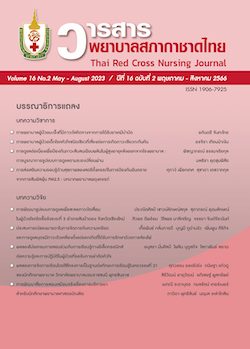Promoting Health Literacy Among Pregnant Women to Prevent Fine Particulate Matter (PM2.5) Exposure: A Midwife’s Role
Keywords:
health literacy, midwife’s role, pregnant women, fine particulate matter (PM2.5) exposureAbstract
The prevalence of PM2.5 particulate matter has been increasing in Thailand. Inhalation of PM2.5 can cause obstetric complications such as pregnancy induced hypertension (PIH), gestational diabetes mellitus (GDM), preterm labor, and a low birth weight for the child. Health literacy encompasses the cognitive and social skills that determine an individual’s motivation and self-care ability. Therefore, midwives should play a vital role promoting health literacy among pregnant women; through demonstrating abilities such as access, understanding, communication, self-management, decision-making and media literacy, midwives can help pregnant women reduce their PM2.5 exposure to improve the health of preg
References
World Health Organization. Ambient (outdoor) air pollution [Internet]. 2021 [cited 2023 Mar 21]. Available from: https://www.who.int/news-room/fact-sheets/detail/ambient-(outdoor)-air-quality-and-health.
Ministry of Public Health, Department of Disease Control. Manual for surveillance, prevention, and control of diseases and health threats caused by PM 2.5. Bangkok: Aksorn Graphic and Design Publishing Limited Partnership; 2021. (in Thai)
World Health Organization. Burden of disease from ambient air pollution for 2012: summary of results [Internet]; 2019 [cited 2022 Dec 18]. Available from: https://era.org.mt/wp-content/uploads/2019/05/Burden-of-disease-from-Ambient-Air-Pollution-for-2012.pdf.
Chulalongkorn university. Learning to stay with PM2.5 [Internet]. 2019 [cited 2023 Apr 4]. Available from: https://www.chula.ac.th/wp-content/uploads/2019/10/chula-pm25-booklet-1.pdf. (in Thai)
Office of the National Economic and Social Development Council. The thirteenth national economic and social development plan (2023-2027) [Internet]. 2022 [cited 2023 Apr 1]. Available from: https://www.nesdc.go.th/article_attach/article_file_20230307173518.pdf. (in Thai)
Rattasumpun S, Sirabrameesith N, Rattasumpun C. Relationship between health literacy and preventive behavior regarding PM 2.5 exposure among pregnant women, Pathum Thani Hospital. Songklanagarind Journal of Nursing 2022;42(3):53-62. (in Thai)
Feng S, Huang F, Zhang Y, Feng Y, Zhang Y, Cao Y, et al. The pathophysiological and molecular mechanisms of atmospheric PM2.5 affecting cardiovascular health: a review. Ecotoxicol Environ Saf [Internet]. 2023 [cited 2023 Oct 6];249:114444. Available from: https://doi.org/10.1016/j.ecoenv.2022.114444.
Phupong V. Particulate matter 2.5 and obstetric complications. Thai Journal of Obstetrics and Gynaecology 2019;27(1):2-5.
Silbert-Flagg J. Maternal & child health nursing: care of the childbearing & childrearing family. 9th ed. Philadelphia: Wolters Kluwer; 2023.
Daniel S, Kloog I, Factor-Litvak P, Levy A, Lunenfeld E, Kioumourtzoglou MA. Risk for preeclampsia following exposure to PM2.5 during pregnancy. Environ Int 2021;156: 106636. doi: 10.1016/j.envint.2021.106636.
Shen Y, Yu G, Liu C, Wang W, Kan H, Zhang J, et al. Prenatal exposure to PM2.5 and Its specific components and risk of hypertensive disorders in pregnancy: a nationwide cohort study in China. Environ Sci Technol 2022;56(16):11473-81.
Yu H, Yin Y, Zhang J, Zhou R. The impact of particulate matter 2.5 on the risk of preeclampsia: an updated systematic review and meta-analysis. Environ Sci Pollu Res Int 2020;27(30):37527-39.
Zhang Y, Li J, Liao J, Hu C, Cao Z, Xia W, et al. Impacts of ambient fine particulate matter on blood pressure pattern and hypertensive disorders of pregnancy. Hypertension 2021;77(4):1133-40.
Ren Z, Yuan J, Luo Y, Wang J, Li Y. Association of air pollution and fine particulate matter (PM2.5) exposure with gestational diabetes: a systematic review and meta-analysis. Ann Transl Med 2023;11(1):23. doi: 10.21037/atm-22-6306.
Bowe B, Xie Y, Li T, Yan Y, Xian H, Al-Aly Z. The 2016 global and national burden of diabetes mellitus attributable to PM2.5 air pollution. Lancet Planet Health 2018;2(7): e302-e12.
Pathirana MM, Lassi Z, Ali A, Arstall M, Roberts CT, Andraweera PH. Cardiovascular risk factors in women with previous gestational diabetes mellitus: a systematic review and meta-analysis. Rev Endocr Metab Disord 2021;22(4):729-61.
Liu Y, Xu J, Chen D, Sun P, Ma X. The association between air pollution and preterm birth and low birth weight in Guangdong. China BMC Public Health 2019;19(1):3. doi: 10.1186/s12889-018-6307-7.
Zhang X, Fan C, Ren Z, Feng H, Zuo S, Hao J, et al. Maternal PM2.5 exposure triggers preterm birth: a cross-sectional study in Wuhan. China Glob Health Res Policy 2020;5:17. doi: 10.1186/s41256-020-00144-5.
DeFranco E, Moravec W, Xu F, Hall E, Hossain M, Haynes EN, et al. Exposure to airborne particulate matter during pregnancy is associated with preterm birth: a population-based cohort study. Environ Health 2016;15:6. doi: 10.1186/s12940-016-0094-3.
Yuan X, Liang F, Zhu J, Huang K, Dai L, Li X, et al. Maternal exposure to PM2.5 and the risk of congenital heart defects in 1.4 million births: a nationwide surveillance-based study. Circulation 2023;147(7):565-74.
Kaur K, Lesseur C, Deyssenroth MA, Kloog I, Schwartz JD, Marsit CJ, et al. PM2.5 exposure during pregnancy is associated with altered placental expression of lipid metabolic genes in a US birth cohort. Environ Res 2022;211:113066. doi: 10.1016/j.envres.2022.113066.
DeFranco E, Hall E, Hossain M, Chen A, Haynes EN, Jones D, et al. Air pollution and stillbirth risk: exposure to airborne particulate matter during pregnancy is associated with fetal death. PLoS One 2015;10(3):e0120594. doi: 10.1371/journal.pone.0120594.
World Health Organization. Promoting health: guide to national implementation of the shanghai declaration. Geneva: World Health Organization; 2018.
Nutbeam D. The evolving concept of health literacy. Soc Sci Med 2008;67(12):2072-8.
Nutbeam D. Health literacy as a public health goal: a challenge for contemporary health education and communication strategies into the 21th century. Health Promot Int 2000;15(3):259-67.
Choeisuwan V. Health literacy: concept and application for nursing practice. Royal Thai Navy Medical Journal 2017;44(3):183-210. (in Thai)
Charoenratana C. Preventive behavior regarding PM2.5 exposure among pregnant women [Internet]. Chiang Mai: Sriphat Medical Center; 2019 [cited 2023 Apr 4]. Available from: http://sriphat.med.cmu.ac.th/th/knowledge-374. (in Thai)
Ministry of Public Health, Department of Health. People's guide: how to monitor PM2.5 to be safe. Bangkok: The Agricultural Co-operative Federation of Thailand; 2000. (in Thai)
Arunnart M. Efficiency of commercial face masks in PM2.5 prevention. Rama Med J 2021;44(2):1-17. (in Thai)
Downloads
Published
Issue
Section
License
Copyright (c) 2023 Srisavarindhira Thai Red Cross Institute of Nursing

This work is licensed under a Creative Commons Attribution-NonCommercial-NoDerivatives 4.0 International License.
เนื้อหาบทความหรือข้อคิดเห็นต่างๆ ในวารสารพยาบาลสภากาชาดไทยนี้ เป็นความคิดเห็นของผู้เขียนบทความ ไม่ใช่ความเห็นของกองบรรณาธิการ หรือสถาบันการพยาบาลศรีสวรินทิรา สภากาชาดไทย






